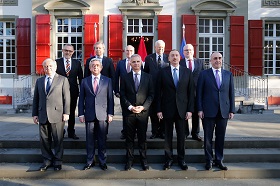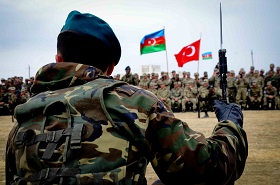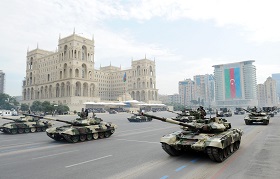Nagorno-Karabakh Conflict: Minsk Process as a Path to Settlement
In
Login if you are already registered
(no votes) |
(0 votes) |
PhD in Engineering, Senior Research Fellow, Head of the CIS Institute Department of Eurasian Integration and SCO Development
Amidst the use of heavy weapons against civilians and others, the situation in Nagorno-Karabakh continues to deteriorate. The current status quo in the conflict zone is no longer stable, making the implementation of even the updated Madrid Principles irrelevant. Under such circumstances, it makes sense to conclude an agreement between the warring parties overseen by the co-chairs of the OSCE Minsk Group on the pullout of heavy and light weapons from actual line of contact, in a similar way to the Minsk II package of measures.
Amidst the use of heavy weapons against civilians and others, the situation in Nagorno-Karabakh continues to deteriorate. The current status quo in the conflict zone is no longer stable, making the implementation of even the updated Madrid Principles irrelevant. Under such circumstances, it makes sense to conclude an agreement between the warring parties overseen by the co-chairs of the OSCE Minsk Group on the pullout of heavy and light weapons from actual line of contact, in a similar way to the Minsk II package of measures.
The Madrid Principles
The OSCE Minsk Group has played an important role in resolving the Nagorno-Karabakh problem, especially since Russia, France and the United States became its co-chairing countries on a permanent basis in mid-February 1997. In November 2007, the three co-chairing countries set forth the principles of the peace settlement of the Nagorno-Karabakh conflict, which are known as the Madrid Principles. They provided for the phased withdrawal of Armenian armed forces (AF) and the demilitarization of the territories surrounding Nagorno-Karabakh, as well as for the introduction of a special regime for the Lachin and Kelbajar districts, including the creation of a transport corridor linking Armenia to Nagorno-Karabakh, and the holding of a referendum to determine the final legal status of Nagorno-Karabakh. The practical implementation of these principles envisaged the introduction of peacekeepers into the conflict zone, international efforts to promote the return of internally displaced persons, as well as mine clearance and the restoration of damaged territories in Nagorno-Karabakh [1].
Since the original version of the Madrid Principles proved unfeasible due to political, ethnical, social and economic reasons underlying the Nagorno-Karabakh conflict, the three leaders (co-chairing countries) of the OSCE Minsk Group instructed their representatives to submit to Baku and Yerevan an updated version of the Madrid Principles, which was done from December 2009 to January 2010. Although both warring parties agreed with the Principles in general, even during the “reset” in Russian-U.S. relations, Washington was not interested in the success of Moscow’s mediation efforts. Therefore, Baku and Yerevan failed to reach any compromise in Kazan in June 2011, in Astrakhan in October 2010, in St. Petersburg in June 2010 or in Sochi in March 2010.
On May 7, 2014, U.S. Co-Chair of the OSCE Minsk Group James Warlick presented a revised version of the Madrid principles at the Carnegie Endowment for International Peace. However, this version was rejected by all parties to the conflict. As a result, in late July-early August 2014, the Nagorno-Karabakh conflict dramatically escalated, which, according to available information, was prompted by Azerbaijani actions.
The current situation in the conflict area

Nagorno-Karabakh conflict peace talks, Bern,
Switzerland, 19 December 2015
The situation in the Nagorno-Karabakh area continues to deteriorate. An incomplete list of recent events is as follows. On the night of December 17-18, 2015, special purpose units of Azerbaijani armed forces attempted to conduct sabotage operations in the southern, eastern, north-eastern and northern defense areas of the Nagorno-Karabakh Republic. Due to active countermeasures by Armenian advanced posts, the enemy suffered losses and was driven back to its starting position. Three Armenian soldiers were killed and four wounded in this clash. Between December 14 and 20, 2015, four Armenian and five Azerbaijani soldiers lost their lives. The overall casualties suffered by Azerbaijan’s armed forces and other security agencies in 2015 amounted to 90 people.
On December 14 and on the night of December 15, 2015, the Azerbaijani side violated the ceasefire regime at the line of contact 150 times. Azerbaijan fired more than 1,700 shots from small arms, 130 shots from 60-mm and 13 from 82-mm mortars as well as 46 shots from AGS-17 and RPG-7 grenade launchers at the NKR Defense Army positions. Stepanakert believes that on December 12 and 13 alone, Azerbaijan violated the ceasefire regime 280 times. For its part, Baku accused the Armenian side of 96 instances of gunfire in just 24 hours and reported about 100 second-strike responses. This situation is due to the fact that there is still no international mechanism to investigate armed incidents in Nagorno-Karabakh.
It should be noted that on the night of December 9, 2015, the Azerbaijani armed forces for the first time since the signing of the 1994 Ceasefire Agreement used tanks to fire on Karabakh positions in the southern direction, not to mention shelling from Turkish-made 107-mm multiple rocket launchers and 122-mm howitzers on September 25. These reaction operations took the lives of not only military personnel, but of civilians of both sides: in late September three civilians were killed and four wounded in the NKR, while the Agdam region of Azerbaijan suffered similar losses.
Russian experts believe that Baku is deliberately exacerbating the situation in order to upset or discredit the status quo in the conflict zone, as the latter isn’t exactly what the Azerbaijani leadership is looking for in terms of propaganda or domestic and foreign policy. Armenian armed forces have to respond to the hostile actions of the enemy. The escalation of tension is being accompanied by commando-type reconnaissance activity, resulting in casualties on both sides.
On December 22, press secretary of Armenia’s Defense Ministry Artsrun Hovhannisyan described the situation on the border with Azerbaijan as war. Under such circumstances, the logic of the Armenian armed forces suggests taking preventative measures to disrupt provocative actions by the Azerbaijani side. In particular, the Azerbaijani armed forces have regularly increased the caliber of weapons used, including tanks and D-30 howitzers. However, notwithstanding the losses suffered by the Armenian side, these Azerbaijani actions fail to accomplish their identified goals, as they encounter a more powerful counterblow.
Syria’s repercussions for Nagorno-Karabakh
There is little doubt that the situation in Nagorno-Karabakh is adversely-affected by the complex military-and-political background in the Middle East, where Syria and Iraq are involved in a vigorous struggle against the radical organization of Islamic State. In particular, at least 300 to 1500 Azerbaijanis are fighting on the side of the Islamic State, which is banned in Russia, and, most probably, will be forced to return to their own country in the short term, following the defeat of major terrorist groups.
Amidst serious socio-economic problems, including those generated by low world oil prices, radicalism is gaining ground in Azerbaijan. It should be noted that such sentiments are witnessed not only among the relatively few Wahhabis (Sunnis), but among the Shiites too, who represent the majority of the population. Recent events in Nardaran prove that.That could encourage Baku to try to resolve the Karabakh problem by force in order to switch growing discontent onto the struggle against an “external enemy.”
The escalated Turkish-Russian confrontation pursues the same goals. Thus, the appeals to create additional problems for Moscow, including through the escalation of the Nagorno-Karabakh conflict, are gaining momentum in Ankara. It is worth recollecting that Turkish multiple rocket launchers of TR-107 type were used to shell Armenian villages. According to reports, there are not only Turkish instructors in the Azerbaijani army, but sometimes active duty Turkish officers too, who actually run reconnaissance and sabotage activities against the Armenian side.
Is this a way for the Nagorno-Karabakh conflict?
As the caliber of used weapons continues to increase, putting an end to the escalation of the armed conflict appears to be more important than ever.
On December 19, 2015 Bern hosted a meeting between Armenia’s President Serzh Sargsyan and Azerbaijan’s President Ilham Aliyev, who took a shot at settling the Nagorno-Karabakh problem. This meeting was held on the initiative of Switzerland amidst escalated tension in the zone of the armed conflict under consideration. Russian experts believe that it failed to produce serious results, which testifies to the inadequacy of efforts undertaken by the OSCE Minsk Group Co-chairmen J. Warlick, I. Popov and P. Andre, as well as to the absence of a functioning international mechanism to investigate incidents in the armed conflict zone (according to some reports, it is the Azerbaijani side that is blocking progress in this direction). As a result, the negative scenario prevails, and the process of negotiation is only being simulated.
Under such circumstances, it is considered by many that “the status quo in Nagorno-Karabakh has become unstable,” making the issue of implementing even the updated Madrid Principles irrelevant. As the caliber of used weapons continues to increase, putting an end to the escalation of the armed conflict appears to be more important than ever. Unlike in August 2014, when shots were fired from heavy machine guns, now mortars and heavy weapons such as tanks, artillery and multiple rocket launchers are being used. There is a real threat of the armed conflict escalating, and the warring parties should immediately consider the issue of pulling out heavy (light) weapons from their positions, as it was done in Donbass, and be aware of the factors that hampered the complete implementation of Minsk Agreement of February 12, 2015. Reports on the concentration of Ukrainian troops and a significant amount of different types of weapons in the immediate battle area are quite alarming and ongoing.
In practice, the implementation of the above agreements implied pulling out all types of weapons, both heavy and light (with a caliber of more as well as less than 100 mm) to an equal distance from the front line to prevent their immediate combat use without being relocated to a new position. In this regard, it seems relevant to look at the Soviet (Russian) weapons of Azerbaijan that form the basis of the combat potential of the national army.
Currently, Azerbaijan’s land forces are armed with T-90S and T-72 tanks (effective range up to 10,0 km); Nona-S and Vena 120-mm self-propelled mortar/cannons (maximum range 14,0 km); Gvozdika 122-mm self-propelled howitzers (range up to 15.2 km); 2S3 Akatsiya 152,4-mm self-propelled artillery and 2S19 MSTA-S (29,1 km); 2S7 Pion 203-mm self-propelled guns (47,5 km); D-30 122-mm howitzers (22,0 km); M-46 130-mm towered field gun (37 km); Giatsint-B 152-mm towered field guns (40 km); D-20 152-mm gun-howitzer (24 km); BM-30 Smerch 300-mm heavy multiple rocket launchers (120 km); BM-27 Uragan 220-mm self-propelled multiple rocket launcher systems (35,8 km); TO1-1A Solntsepyok 220-mm heavy shooting systems (6,0 km); BM-21 Grad 122-mm MLRS truck-mounted multiple rocket launchers (42 km); Tochka-U tactical ballistic missile complexes (120 km); PM-38 and 2B-11 120-mm mortars (9,0 km); and 2B14-1 Podnos 82-mm mortars (3,9 km).
Analyzing the data shows that Azerbaijan has used a long list of weapons (let alone weapons of Azerbaijani, Israeli and Turkish origin) that have different firing ranges. Among them, the BM-30 Smerch 300-mm heavy multiple rocket launchers and Tochka-U tactical missile systems with a firing range of over 100 km, as well as TO1-1A Solntsepyok 220-mm heavy shooting systems pose the greatest danger to the civilian population. A ban on their tactical employment in the Nagorno-Karabakh conflict should be the first step on the way to a settlement. In addition, Russia could undertake a commitment to refrain from supplying these types of weapons to the warring parties.
The next step might involve pulling out both heavy and light weapons to an agreed-upon distance, determined by the type and caliber of ammunition used. The foundation for this could be laid by an agreement similar to the Minsk II package of measures, agreed to at the summit in Minsk on February 11-12, 2015 by the Norman Quartet (Germany, France, Ukraine and Russia) and signed by the Contact Group on the settlement of the Ukrainian crisis that includes representatives of Ukraine, Russia, the OSCE, Donetsk and Luhansk People's Republics.
Thus, in compliance with the provisions of Para 2 of Minsk Agreement, it was decided to pull out “all heavy weapons by both sides to equal distance with the aim of creation of a security zone on minimum 50 kilometers apart for artillery of 100 mm caliber or more, and a security zone on minimum 50 kilometers for multiple rocket launchers (MRLS) and 140 kilometers for MLRS Tornado-S, Uragan, Smerch, and Tochka-U tactical missile systems.”
As such, specific aspects of the situation in Nagorno-Karabakh should be taken into account. The capital of Nagorno-Karabakh Stepanakert and certain other major inhabited localities of the NKR are situated relatively close to the front line. Therefore, the withdrawal of Armenian and Azerbaijani weapons should allow for the actual location of settlements and be carried out, among other things, on a pro rata basis (the distance of the pullout of the weapons could be reduced to the agreed-upon parameters if existing weapons fail to provide adequate cover to settlements).
The OSCE Minsk Group co-chairs should assume a leading role in reaching an agreement on the pullout of heavy (light) weapons and its implementation. At the same time, both Armenia and Azerbaijan are able to confirm this pullout of weapons through the use of available reconnaissance resources. The possibility of returning the weapons to their initial position in a fairly short period of time (within a few hours) is quite a different matter. To prevent the latter, mutual trust should be built up near the line of contact, which implies abandoning reconnaissance and sabotage operations in the area and withdrawing of snipers from it.
If such agreements are reached, the issues of effective monitoring, verification of ceasefire regime and pullout of heavy (light) weapons will assume a key importance. This task could be committed to the relevant OSCE mission, which, for example, on December 2, 2015 conducted a planned monitoring of the Line of Contact between the armed forces of Nagorno Karabakh and Azerbaijan in the Askeran direction. But this is not nearly enough to do the job: the OSCE monitoring mission should function on a permanent basis and, as the Minsk II Agreement specifies, be equipped with the necessary technical means, such as satellites, drones, radio-location systems, etc. This will require significant financial resources and convincing the warring parties that these technical means will not be used to gather intelligence to the benefit of one party to the conflict. However, only this will allow for tensions to be significantly relaxed on the front line and to proceed towards a conflict settlement on the basis of the updated Madrid principles among other things.
Special consideration should be given to extending the format of negotiations and including representatives of the NKR in them. Such a trilateral format did exist in 1994-1997, but then it was decided to abandon it for various reasons. The trilateral format (Nagorno-Karabakh-Azerbaijan-Armenia) established within the framework of the Russian-American Dartmouth Conference on Nagorno Karabakh (the second negotiation process at the level of top experts) was maintained since its establishment in 2001 until the end in 2012.
Apparently, there is a need to return to the original format of negotiations, which contributed to the reaching of serious agreements in the past and would allow for new agreements in the near future. The key to this is establishing statehood in the Nagorno-Karabakh Republic: the democratic parliamentary elections held in early May 2015 bear irrefutable evidence of it.
Therefore, the experience of efforts to settle the conflict in Donbass on the basis of Minsk II Agreements can help reduce tension in the Nagorno-Karabakh region, and launch a process of resolving this conflict in line with the updated Madrid Principles proposed by the U.S., Russia and France. To this end, it appears expedient to conclude an agreement between the warring parties, overseen by the OSCE Minsk Group co-chairs, on the pullout of heavy and light weapons from the actual line of contact, in a similar way to the Minsk II package of measures. When this is not the case, the armed confrontation in the Nagorno-Karabakh region and along the Armenian-Azerbaijani border is bound to escalate.
References
Nichol J. Armenia, Azerbaijan, and Georgia: Political Developments and Implications for U.S. Interests. Congressional Research Service. Washington D.C. 2009. April 9. PP. 11 – 13.
(no votes) |
(0 votes) |






